General O’Connor, one of the most distinguished soldiers of the War of Independence, played an important part in the final victory of Ayachucho. For his gallantry on that day he was promoted to the rank of general by the commander-in-chief, General Bolivar. After the War of Independence he became Minister of War in Bolivia. General O’Connor went to South America as an ensign in the Irish Legion under General Devereux. He claimed direct descent from Roderic O’Conor, last king of Ireland, 1186.
Captain Esmonde also fought in the War of Independence. He was brother to the then baronet, Sir Thomas Esmonde, of Co. Wexford. In later years Captain Esmonde was employed by the Peruvian government to report on some proposed canals at Tarapaca. The vessel in which he embarked was never more heard of.
Colonel Charles Carroll had served in Spain, but joined the Chilian army after independence was gained. He was one of the most popular officers in the army, and met with a sad fate. Being sent with too small a detachment against the savage Indians, their commander, Benavides, cut his forces in pieces and murdered all the officers in a most cruel manner. O’Carroll had his tongue cut out and was then butchered.
Lieutenant Colonel Moran, who commanded the Colombian legion at the battle of Ayachucho, probably came out in the legion of General Devereux.
Colonel (afterwards General) O’Leary was first aide-decamp to General Bolivar, the Liberator, and received his last breath. He was nephew to the famous Father Arthur O’Leary. Bolivar employed him on various missions of great trust and says “he acquitted himself with great ability.” After the war, General O’Leary was appointed British charge d’affaires at Bogota, and died in Rome in 1868. General Arthur Sandes, a native of Dublin, was entrusted with an important garrison in Peru on the close of the War of Independence.
Admiral Brown, the distinguished commander and hero of the War of Independence, whose exploits may be ranked, like those of Nelson, “above all Greek, above all Roman fame,” was born at Foxford, Co. Mayo, Ireland, on the 22nd of June, 1777. His father emigrated with his family to Pennsylvania. A ship captain who was about to sail from Philadelphia offered to take the intelligent Irish boy with him, and the offer was promptly accepted. During twenty years he seems to have voyaged to many countries;




